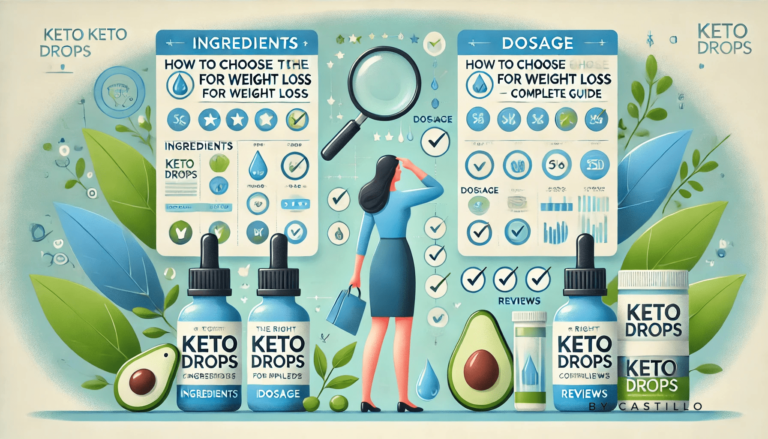12 Powerful Keto Tips To Follow Before You Start The Ketogenic Diet
Are you planning on starting the ketogenic diet? Well, you are in luck. I have 12 powerful keto tips you can follow to kick-start your keto lifestyle.
Starting any diet can be challenging and the ketogenic diet is no different. This is why I wanted to share these 12 keto tips with you to stay on track!
Following even a few of these keto tips will get you off to a good start. You may even start noticing weight loss a little sooner than later.
Now let’s kick start your keto diet success.
12 Powerful Keto Tips to Follow
- Understand How The Ketogenic Diet Works
- Be Mindful Of Your Macronutrients
- Decrease Carbs Slowly Over Time
- Try Intermittent Fasting
- Stay Hydrated
- Limit Artificial Sweeteners and Processed Foods
- Test Ketone Levels
- Read Food Labels
- Use MCT Oil
- Get Into A Workout Routine
- Increase Electrolyte Intake
- Prepare Meals
Keto Tip 1: Understand How The Ketogenic Diet Works

The ketogenic diet is one of the best ways to lose weight and reduce body fat by decreasing your carbohydrate intake, increasing your healthy fat intake, and moderating protein intake. That is it!
Don’t overthink it.
Decrease the carbs, increase healthy fat intake, and moderate the protein.
If you are wondering why we must limit our carb cravings, it’s because carbohydrates spike our insulin the most out of all the macronutrients. When you eat food with high carbohydrates, insulin kicks in and will start converting glucose (blood sugar) into glycogen (stored sugar) in the liver and muscles. Which in simple terms is stored as fat! This is what we want to avoid while on the keto diet.
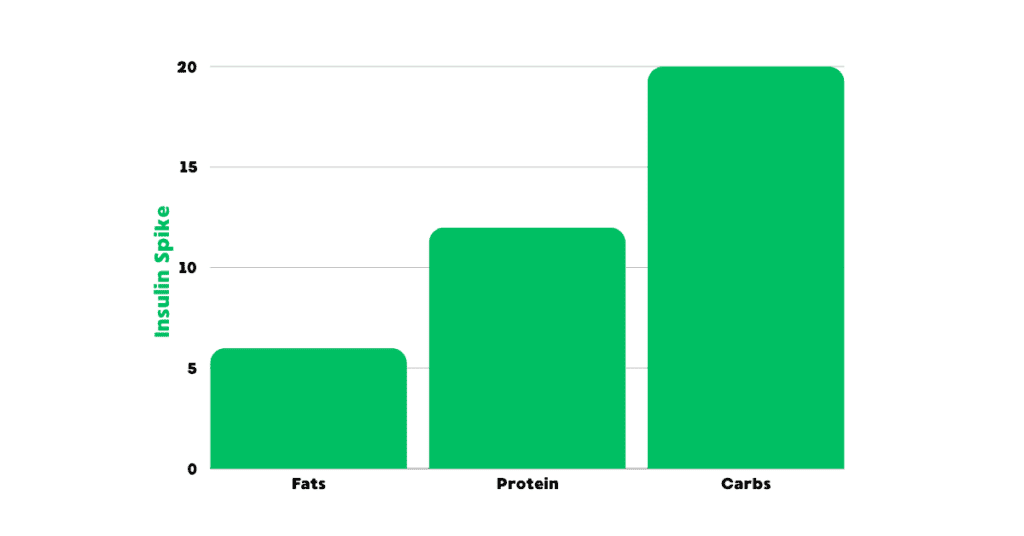
What Is Insulin?
Insulin is a hormone produced by the pancreas and helps regulate blood sugar (glucose) in the body. It has the following functions:
Glucose Uptake – Energy Boost for Cells:
Insulin is like the VIP pass for glucose, helping muscle, fat, and liver cells snatch it up from the bloodstream. It’s the energy kick these cells need to stay on top of their game.
Glycogen Synthesis – Glycogen Party In the Liver:
Picture insulin as the event planner for glucose-turned-glycogen in the liver. It’s stored sugar that’s ready to transform back into glucose whenever the energy spotlight is on.
Restrains Glucose Production – Glucose Police at the Liver:
Insulin also plays the cool cop at the liver, putting the brakes on glucose (blood sugar) production. This keeps a lid on excessive glucose in the bloodstream, especially when your diet’s on a bit of a carb
Protein Synthesis – Protein Synthesis Maestro:
When it comes to cell growth, repair, and maintenance, insulin takes the lead in the protein synthesis orchestra. It’s like the conductor making sure everything is harmonious.
Prevents Fat Breakdown – Fat Breakdown Bodyguard:
Insulin is like the hero in the fat-loss fighting game. It’s your body’s sugar storage manager. When there is too much sugar in the blood (aka excess glucose), insulin steps in to keep it in check by tucking it away as fat in the adipose tissue. The adipose tissue is that cool connective tissue spread out like a VIP throughout your body. It’s under your skin, between organs, and even throwing a shining in bone cavities.
The catch?
The more fat in these tissues, the more weight you might appear to be carrying.
When you spike insulin by eating foods rich in carbohydrates, insulin steps in to prevent the breakdown of fats in the adipose tissue.
Just think of insulin as the hormone that signals your body to store sugar as fat when there is too much sugar in the blood (excess glucose). So, to promote healthy weight loss on the keto diet you have to keep your insulin levels down for it to signal your body to start producing ketones.
Once your liver starts producing ketones, you have officially entered a ketosis state. When your body is in a ketosis state, it naturally burns fat as fuel.
Different Types Of Keto Diets
There are different types of ketogenic diets you can follow depending on your fitness and weight loss goals. You can modify the main principles of the ketogenic diet to build muscle, lose weight faster, improve energy, and much more.
Here is a list of different ketogenic diets to give you an idea of how they differ from one another:
- Lazy Keto Diet: Best for anyone getting started
- High Protein Keto Diet: Best for bodybuilders or anyone trying to gain muscle on the ketogenic diet
- Speed Keto: Best for anyone trying to lose weight and burn fat fast
- Targeted Keto Diet: Best for athletes who are trying to enhance their performance while on the ketogenic diet
- Cyclical Keto Diet: Best for beginners, gym-goers, and athletes
Got it? Good, let’s keep going.
Keto Tip 2: Be Mindful of Your Macronutrients
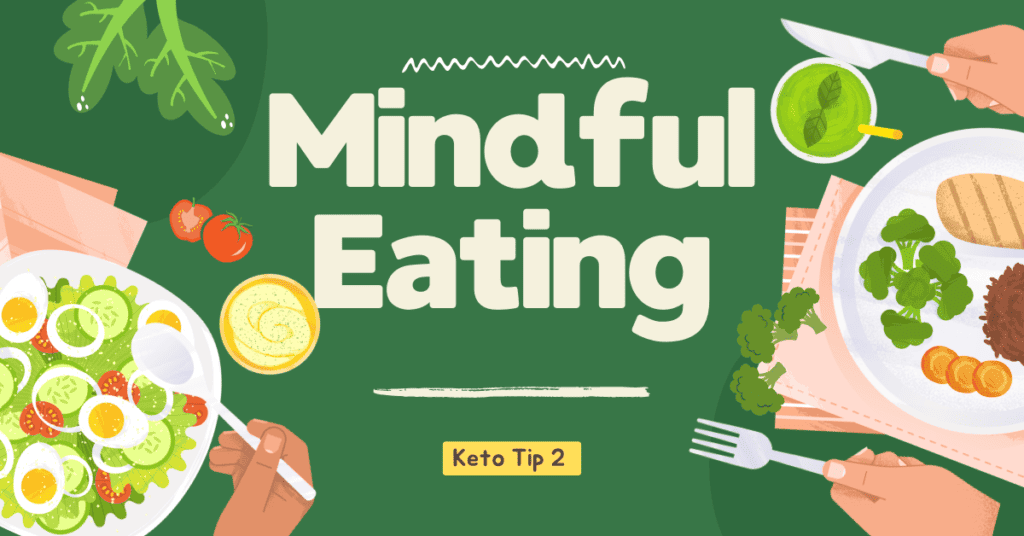
Yes, you have to know your macronutrients. Don’t worry, though—it’s not that hard to keep track while on the ketogenic diet.
What I found more important while on the keto diet is to focus on the type of macros you consume and be mindful of your macronutrient intake.
Consuming healthy fats, moderating protein, and eating low-carb foods will help you stay on track.
Don’t worry about counting calories, we are not here to compete on stage for the best physique.
We just want to reduce body fat and lose weight.
Like any diet, you do not want to overeat. So keep things simple and stop eating once you feel full!
The goal of the keto diet is to get into ketosis.
Once you reach ketosis, your body turns into a natural fat-burning machine and you will see the fat just melt away as you stay in ketosis.
Below are the macro ratios you should follow for your keto journey:
70 – 75% healthy fats
20 – 25% protein
5 – 10% carb
Feel free to adjust the ratios slightly if needed when starting. But try to keep your macros as close as possible to those ratios.
We want to keep blood sugar levels low to prevent insulin from spiking too much, and each macronutrient (carbs, fats, and protein) affects insulin differently.
For instance, carbs spike your insulin the most. Protein also spikes insulin, but not as bad as carbs. Consuming high-fat foods spikes insulin the least, which is why healthy fats are our friend on the keto diet.
Keto-Friendly Foods To Help You Stay On Track!
Be on your way to nutritional ketosis. Use these keto-friendly foods to create delicious keto recipes.
| Food | Serving Size | Calories | Fat (g) | Protein (g) | Net Carbs (g) |
| Avacado | 1 medium (201g) | 322 | 29 | 4 | 2 |
| Salmon | 3 oz (85g) | 177 | 10 | 19 | 0 |
| Eggs | 2 large | 143 | 10 | 13 | 1 |
| Chicken (skin-on) | 3 oz (85g) | 167 | 8 | 21 | 0 |
| Beef (steak) | 3 oz (85g) | 213 | 15 | 19 | 0 |
| Bacon | 2 slices (30g) | 86 | 7 | 5 | 0 |
| Cauliflower | 1 cup (100g) | 25 | 0 | 2 | 2 |
| Broccoli | 1 cup (91g) | 31 | 0 | 3 | 3 |
| Spinach | 1 cup (30g) | 7 | 0 | 1 | 1 |
| Zucchini | 1 medium (196g) | 33 | 1 | 2 | 6 |
| Olive oil | 1 tbsp (13.5g) | 119 | 14 | 0 | 0 |
| Coconut oil | 1 tbsp (13.6g) | 121 | 14 | 0 | 0 |
| Butter | 1 tbsp (14g) | 102 | 12 | 0 | 0 |
| Cheese (cheddar) | 1 oz (28g) | 110 | 9 | 7 | 0.5 |
| Almonds | 1 oz (28g) | 160 | 14 | 6 | 2.5 |
| Walnuts | 1 oz (28g) | 183 | 18 | 4 | 2 |
| Ground flaxseeds | 2 tbsp (24g) | 74 | 6 | 2 | 0.5 |
| Greek yogurt (full-fat) | 1/2 cup (113g) | 149 | 10 | 11 | 4 |
| Heavy cream | 2 tbsp (30g) | 103 | 11 | 1 | 0.5 |
| Cauliflower rice | 1 cup (100g) | 25 | 0 | 2 | 2 |
| Brussels sprouts | 1 cup (88g) | 38 | 0 | 3 | 5 |
| Shrimp | 3 oz (85g) | 84 | 1 | 18 | 0 |
| Bell peppers | 1 medium (186g) | 25 | 0 | 1 | 4 |
| Mushrooms | 1 cup (70g) | 15 | 0 | 2 | 2 |
| Green beans | 1 cup (125g) | 31 | 0 | 2 | 6 |
| Pork rinds | 1 oz (28g) | 152 | 9 | 17 | 0 |
| Dark chocolate (85%+) | 1 oz (28g) | 155 | 14 | 2 | 5 |
| Coconut milk | 1 cup (240g) | 552 | 57 | 6 | 6 |
| Avocado oil | 1 tbsp (14g) | 120 | 14 | 0 | 0 |
| Cabbage | 1 cup (89g) | 22 | 0 | 1 | 5 |
These keto-friendly foods are great options for putting a few keto meals together.
Keep the following in mind:
Failing to keep your carbs low enough will prevent you from reaching ketosis.
Consuming enough fats will make you feel lethargic, making staying consistent impossible.
Eating too much protein will convert into glucose and spike insulin. Which will kick you out of ketosis.
Keto Tip 3: Decrease Carbs Slowly Over Time
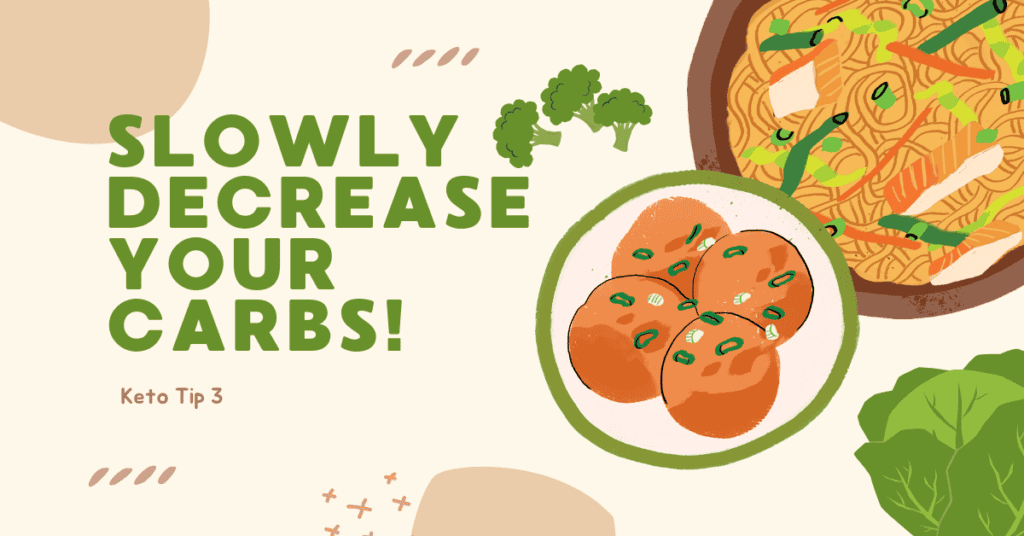
I wish someone had told me this when I started the keto diet.
Limiting carbs is difficult!
You do not realize how much you love carbs until you decrease them over time. But don’t lower your carbs too quickly!
Decreasing your carbs too quickly will most likely give you the keto flu. Symptoms include headaches, fatigue, dizziness, nausea, irritability, and difficulty concentrating.
It sucks, but it goes away within a few days as your body starts to adapt to your new keto diet.
To transition smoothly into your new keto lifestyle and avoid the keto flu, follow these 5 steps below.
Keep Tabs on Your Carb Intake
Keep a food diary to track your current carbohydrate intake. This will give you a baseline understanding of how many carbs you consume daily. Aim to reduce this amount gradually over a few weeks.
Embrace Whole, Low-Carb Goodies
Instead of eliminating all carbs immediately, focus on replacing high-carb foods with low-carb alternatives. Include plenty of non-starchy vegetables, such as leafy greens, broccoli, and cauliflower. Choose whole, unprocessed foods and prioritize sources of healthy fats, like avocados, nuts, and olive oil.
Cut Back on Sugar and Processed Carbs
Say goodbye to added sugars, refined grains, and tempting processed snacks. Choose whole, nutrient-packed foods that keep your energy steady without causing a wild spike in blood sugar levels (glucose).
Downsize Those High-Carb Foods
Rather than bidding farewell to certain foods, try a more gradual approach. Trim down the portion sizes of those higher-carb items in your meals. If you’re a rice or pasta fan, start by scaling back and tossing in extra veggies or a moderate amount of a low-carb substitute like cauliflower rice.
Play Around with Low-Carb Swaps
Get creative in the kitchen and experiment with low-carb alternatives for your usual go-tos. Swap almond or coconut flour for wheat flour in your baking adventures, or go for lettuce wraps instead of bread for sandwiches. These swaps let you savor familiar flavors while keeping things on the lower-carb side.
Remember, it’s all about approaching this the right way and finding what works best for you!
Keto Tip 4: Try Intermittent Fasting

Intermittent fasting with the keto diet is like a cheat code! It can help decrease the time it takes you to get into ketosis, but I would not recommend it when starting your keto diet. Once you get used to being on a low-carb diet, you can slowly start incorporating intermittent fasting.
What is Intermittent fasting?
Intermittent fasting is like a bit of eating dance, where you cycle between times of eating and not eating. A popular way to do this is the 16/8 method. Fasting for 16 hours and giving yourself an 8-hour eating window. There are different methods of doing this but the 16/8 is one of the easiest ways to get started.
Here are some additional benefits of intermittent fasting:
- Weight Loss: Intermittent fasting can lead to a reduction in calorie intake, aiding in weight loss.
- Improved Metabolic Health: It may enhance insulin sensitivity, regulate blood sugar levels, and reduce the risk of type 2 diabetes.
- Heart Health: Intermittent fasting may contribute to lower blood pressure, improved cholesterol levels, and a reduced risk of heart disease.
- Cellular Repair: Fasting triggers cellular repair processes, including autophagy, where cells remove damaged components.
- Brain Health: Some studies suggest that intermittent fasting may support brain health, promote cognitive function, and reduce the risk of neurodegenerative diseases.
- Inflammation Reduction: It may help decrease inflammation, which is linked to various chronic diseases.
- Longevity: Some animal studies suggest that intermittent fasting may increase lifespan, though more research is needed in humans.
- Cancer Prevention: While more research is required, some studies propose that intermittent fasting may help reduce the risk of certain cancers.
- Improved Blood Lipids: It can positively influence lipid profiles by reducing triglycerides and improving HDL cholesterol levels.
It’s all about giving your body a chance to use stored energy (glycogen stores), burn fat, and boost focus.
Keto Tip 5: Stay Hydrated!
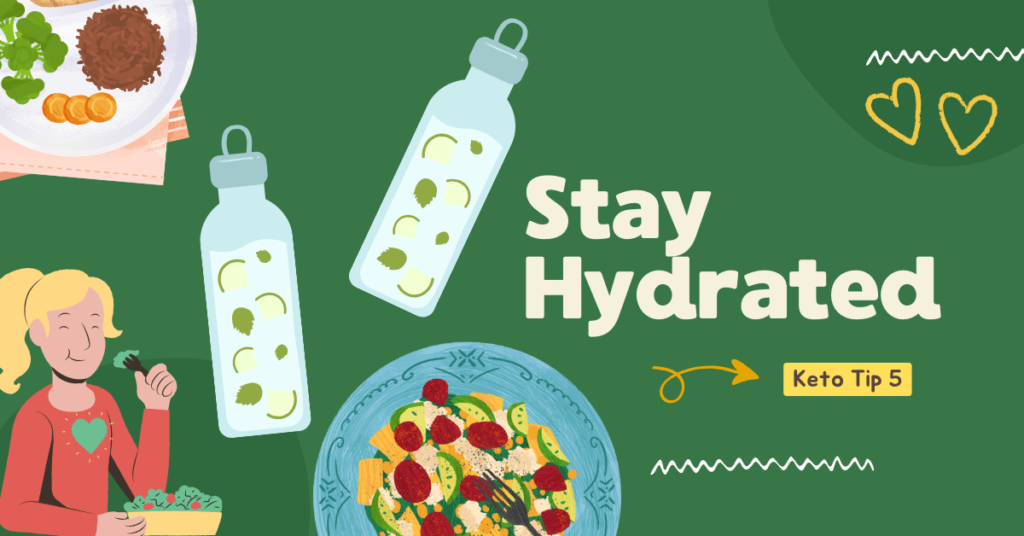
Let’s discuss why staying hydrated is key when rocking the keto lifestyle.
When you’re on the keto journey, your body switches gears and starts using fat for fuel instead of carbs. As you burn through fat, your body releases ketones, and these little guys need some water to tag along.
Hydration becomes your keto sidekick, helping your body adjust to this awesome new fat-burning-energy mode. Plus, since you’re cutting back on carbs, you might notice a drop in water weight initially. Staying hydrated helps balance things out and keeps you feeling fantastic.
Water also plays a superhero role in supporting digestion, which is important when you’re preparing all those delicious keto meals.
Keto Tip 6: Limit Artificial Sweeteners and Processed Foods
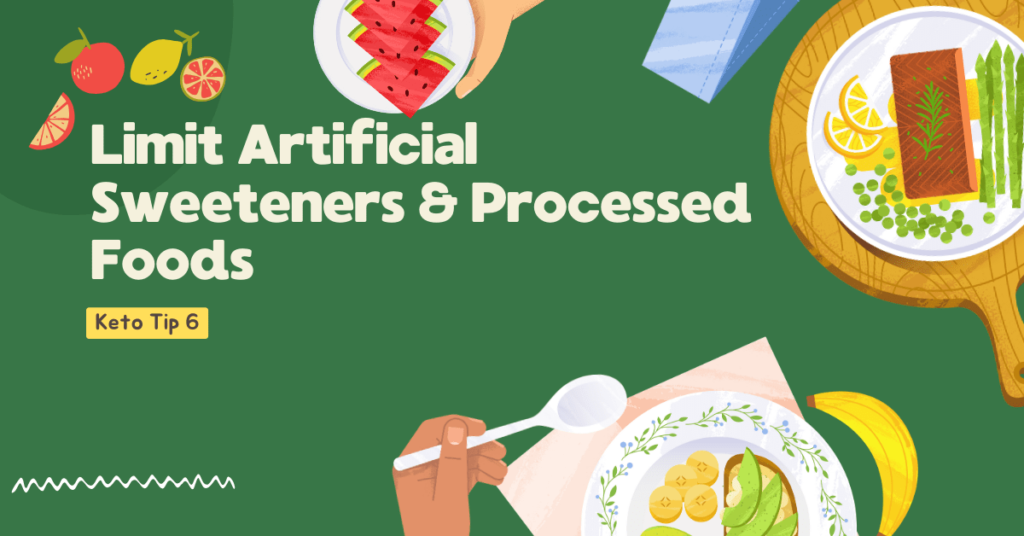
Picture this: Avoiding artificial sweeteners and giving processed foods the boot is like unleashing the keto magic within.
Artificial sweeteners? Sneaky culprits, right? Some hide those pesky hidden carbs that can mess with your groove and, more importantly, your mission to maintain ketosis. We’re all about keeping that fat-burning party going strong!
Now, processed foods? They’ve got a knack for playing hide-and-seek with more carbs than you’d think, plus packing a calorie punch. Not exactly the keto dream team we’re after.
Swap these tricksters out for whole, unprocessed goodness, and you’re not just waving goodbye to hidden carbs; you’re giving your body the green light to be a weight-loss rockstar.
Real, nutrient-packed food is your keto superhero, promoting weight loss and keeping that fat-burning bonfire alive. So, ditch the fake stuff, embrace the wholesome, and let’s ride that keto wave together!
Keto Tip 7: Test Ketone Levels
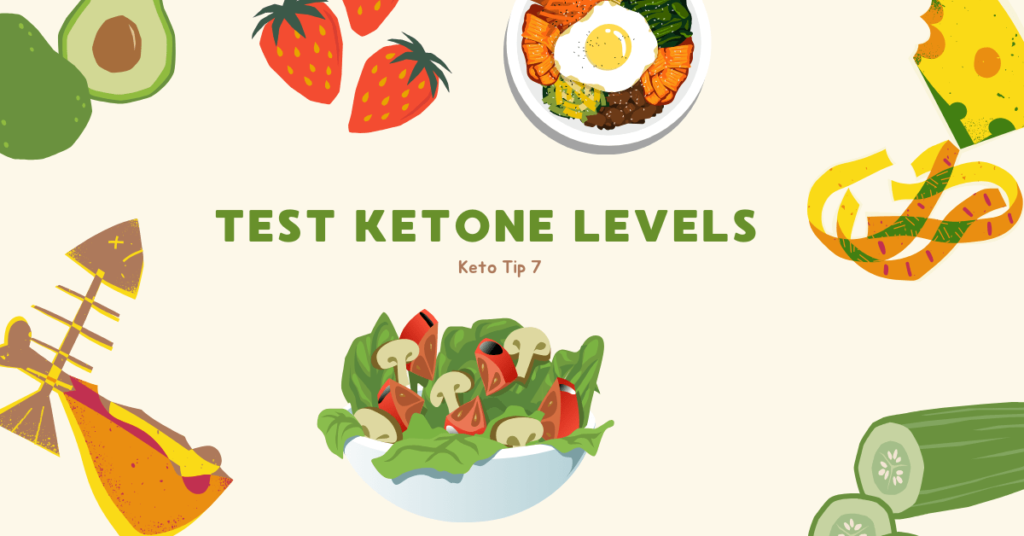
Testing ketone levels on the keto diet can provide valuable insights into the effectiveness of your dietary approach and help you make informed decisions.
Here’s why it’s important:
1. Making Sure You’re in the Keto Zone
Checking your ketone levels is like a little detective work to make sure your body is in ketosis, that awesome fat-burning state. It’s like your body’s secret handshake for the keto club.
2. Getting Personal with Your Diet
Everyone’s body is a bit different, right? Testing your ketones helps determine what carb and fat combo works best for you. It’s like having a personal keto compass to navigate your way to optimal ketosis.
3. Fine-Tuning Your Food Choices
Ever wish you could customize your meals based on how your body reacts? Well, testing your ketones lets you do just that. You can tweak your food choices to keep that sweet spot of ketosis going strong.
4. Checking Out Your Keto Lifestyle
Think of ketone testing as your keto diary. It lets you look back and see how far you’ve come. Did that new recipe send your ketones soaring? It’s like a progress report for your keto adventure.
5. Staying Inspired on the Keto Path
Seeing those ketone levels can be downright motivational. It’s like a high-five from your body saying, “Hey, you’re rocking this keto thing!” Plus, it keeps you on track with your keto goals.
Remember, while ketone testing is cool, it’s just one piece of the puzzle. Your overall well-being and how you feel on the keto diet are just as important.
Keto Tip 8: Read Food Labels
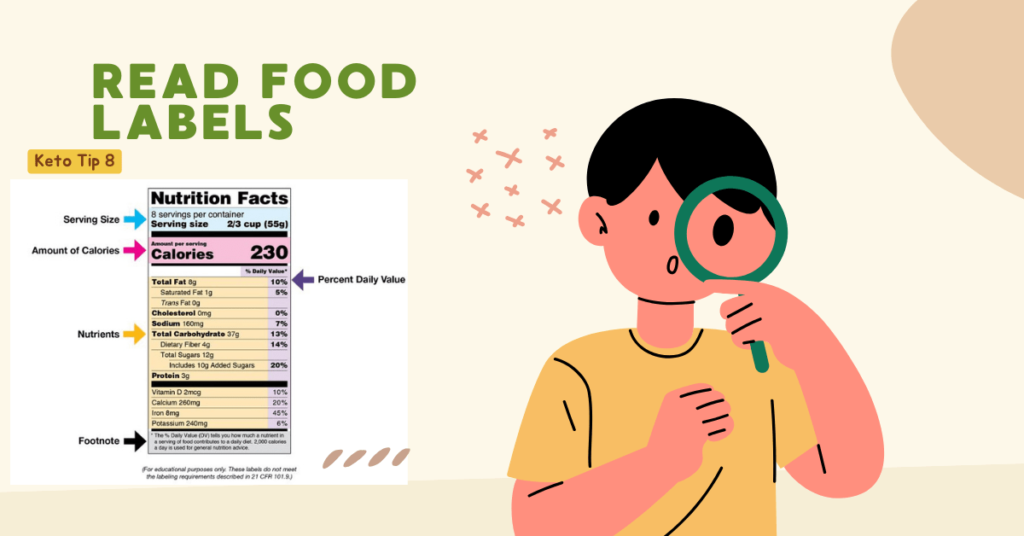
Let’s dive into the why and how of decoding food labels on this epic keto adventure. Trust me, it’s not just about reading, it’s your secret sauce for weight loss magic!
Picture this.
Weight loss is our superstar goal, right? So, when you’re eyeballing those food labels, focus on the low-carb gems. These are the game-changers on your keto quest, paving the way for your ultimate weight loss journey.
It’s like having your own personalized roadmap, steering you towards success.
Now, let’s talk meal planning, your trusty sidekick. When you get cozy with those labels, you’re not just picking what tastes great; you’re crafting a low-carb meal plan- your weight loss weapon. Double win!
But wait, there’s a keto ninja move, net carbs.
They’re the carb count that matters for your weight loss goals.
Here’s the math to calculate your net carbs:
Total Carbs minus Fiber equals Net Carbs.
It’s the secret handshake to unlock the low-carb wonders on the label. So, embrace the label detective in you, calculate those net carbs, and let the weight loss adventure roll!
Keto Tip 9: Use MCT Oil
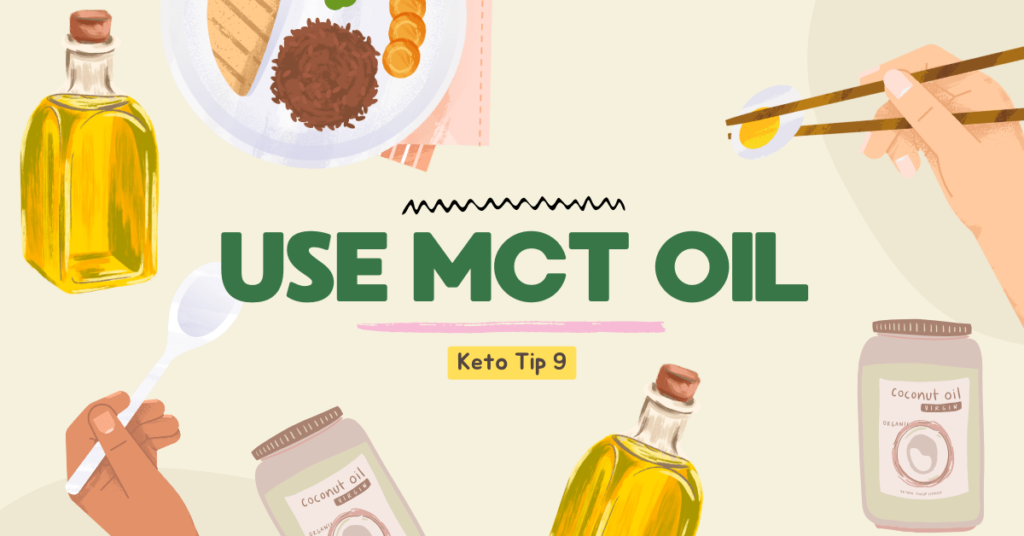
Why is it a game-changer on this weight loss journey? Picture it as the magic elixir in your keto toolkit. Here’s why.
First, MCT oil is a great weapon for losing weight. It’s like a boost for your metabolism, revving it up to torch those extra calories. Plus, it’s a champ at helping you feel full, so you’re not tempted to sneak in those sneaky snacks that might slow down your weight loss goals.
Here is where it gets interesting.
MCT oil contains amino acids, the building blocks of protein. It’s like giving your body a mini treasure chest of goodies to support your muscles and keep you rocking on your weight loss journey.
And get this.
MCT oil is like the rockstar of healthy oils. It’s quick to digest, offering up a speedy energy boost without hanging around to cause trouble.
BONUS: It has fewer calories than some other fats, making it a go-to for those aiming to shed pounds.
Make sure to pick up a bottle of MCT oil next time you are at the grocery store.
Keto Tip 10: Get Into a Workout Routine!
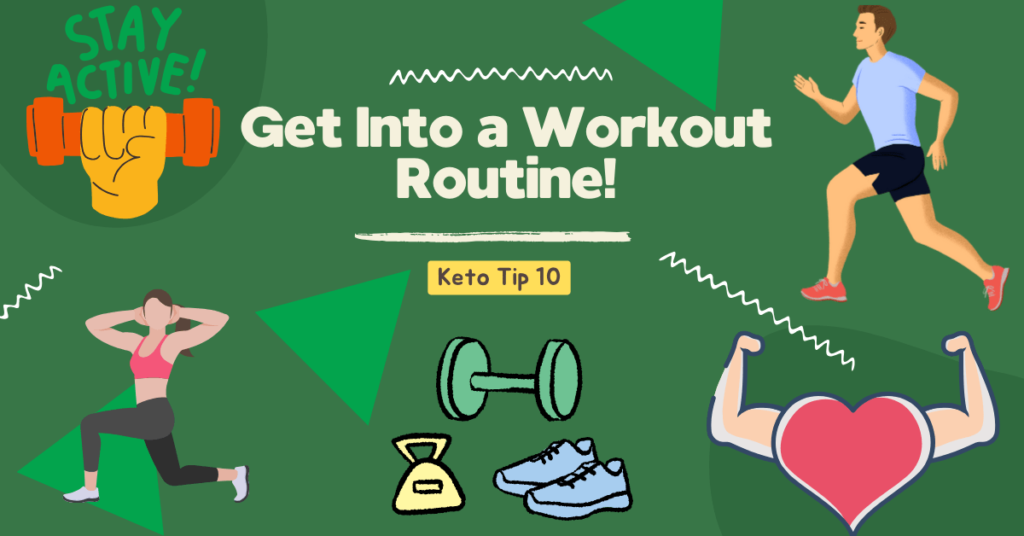
If you don’t have a workout routine yet, create one. Seriously, get out there and get your blood pumping, your joints moving, and your muscles working. You will be glad you did!
Find a schedule that works best for you and make it fun to help you stay consistent. Give yourself at least 3-5 days out of the week to exercise.
Working out is going to up your keto game by helping you get into ketosis a lot sooner. It’s the secret sauce that will boost your fat-burning powers and supercharge your overall metabolic mojo. Here’s the lowdown on some exercises that can be your keto BFFs.
High-Intensity Interval Training (HIIT):
HIIT – The rockstar workout in the keto world. High-intensity interval Training, or HIIT, is like a turbo boost for your fitness routine. Picture this: short bursts of intense exercise, like sprinting or jumping jacks, followed by quick breaks.
Now, why is it the perfect match for the keto diet? Well, when you’re all about those low-carb vibes, HIIT steps in to amp up your weight loss game. It’s not just about burning calories during the workout; it revs up your metabolism, turning your body into a fat-burning machine even after you’ve crushed the session.
So, if you’re on the keto diet and looking to shed those pounds, invite HIIT to the party – it’s your dynamic duo for a fitter, leaner you!
Strength Training (Lift Heavy Circles):
Ahh, the magic of strength training. It’s your keto diet’s trusty sidekick on the journey to weight loss. Strength training is like giving your muscles a VIP pass to the workout party.
Think – heavy weights!
Increase the intensity over time to promote more muscle growth and burn more fat! As you’re rocking the low-carb keto diet, strength training becomes another weapon to aid you in losing weight and packing on lean muscle.
It’s not just about building muscles.
It’s about cranking up your metabolism, making your body a calorie-burning furnace. So, if you’re on the keto diet and keen on shedding those pounds, let strength training join the plan – it’s your heavyweight champion for a leaner, stronger you!
Focus on these 3 main lifts: bench, squat, and deadlift.
Do 5 sets and 5 reps with heavy weight.
Ensure you keep good form between the full range of motion and don’t forget to warm up!
Cardio (Think Running, Cycling, Swimming):
Let’s talk about cardio. These heart-pumping exercises will help you lose weight in those unwanted areas. Combining this type of training while on the keto diet will work wonders.
Cardio is like your body’s rhythm section, involving activities that get your heart rate up – think running, cycling, or even a dance session in your living room. Now, why is it a keto favorite?
Picture this.
As you’re rocking the low-carb vibes of the keto diet, cardio becomes the ultimate weight-loss ally.
So, lace up those sneakers, embrace the cardio groove, and let it be the beat to your keto success story!
Easy Does it (Walking):
No need to sprint, a good old walk works wonders while on the keto diet.
It’s simple, gentle, and adds to your daily weight loss mission.
Try to shoot for at least 10,000 to 15,000 steps a day!
Chill Vibes (Yoga and Flexibility):
Stress can mess with your keto groove. Enter yoga – it’s like a zen session that helps balance hormones and keeps you feeling fantastic.
Remember, it’s all about what you enjoy, so pick exercises that make you happy and keep the keto vibes rolling!
Keto Tip 11: Increase Electrolyte Intake

Let’s dive into why boosting your electrolytes is like giving your body a high-five during the ketogenic journey.
So, when you’re rocking the keto diet, your body undergoes some cool changes. As you cut carbs, your insulin levels drop, and you start shedding excess water weight.
Now, while that’s fantastic, it also means bidding adieu to essential electrolytes like sodium, potassium, and magnesium through increased urination.
Here’s where the magic happens – replenishing these electrolytes becomes key. Sodium keeps you hydrated, potassium supports muscle function, and magnesium is your energy MVP.
Low electrolytes can lead to the infamous keto flu – fatigue, cramps, and headaches.
But fear not!
Grabbing that extra pinch of salt, munching on potassium-rich foods like avocados, and considering magnesium supplements can keep you feeling fantastic and energized on your keto adventure. It’s like turbocharging your electrolyte game for a smooth ride!
Keto Tip 12: Prepare Meals
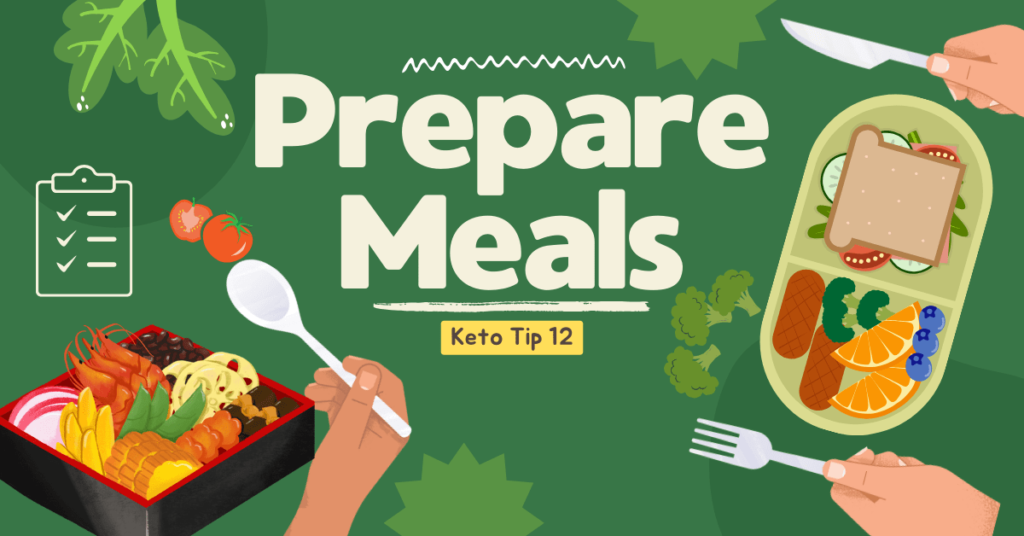
I know, I hate preparing meals also!
It’s very time-consuming and can get messy, depending on what you decide to prepare. But planning your meals on the keto diet is like having a roadmap to success. You can sign up for a friendly keto meal delivery service to make things easier and help save time.
Another approach I would recommend when getting started is lazy keto.
Lazy keto takes all the macro-counting out of the equation and primarily focuses on mindful eating with lazy keto meals. Creating a lazy keto meal plan is easy and does not require a lot of time to prep.
You can always get into a strict keto diet when you feel like you are ready to make that leap!
There are a ton of lazy keto meals for breakfast, lunch, and dinner. They are easy to make and don’t require a ton of time to prep. It’s keto meals on the fly.
Just have a game plan, make a list of your favorite go-tos, and make sure you have all your ingredients ready to go!
With a game plan, you’re not just winging it; you’re ensuring your body gets the right balance of low-carb, high-fat goodness.
Keto is all about kicking those carbs to the curb and welcoming in healthy fats.
When you plan your meals, you’re not just preventing those hangry moments; you’re setting yourself up for a steady supply of energy and keeping those ketones in check.
So, whether you’re whipping up a tasty avocado and bacon salad or savoring a succulent piece of grilled salmon, meal planning keeps you on track, satisfied, and ready to conquer your keto goals. Embrace the plan, and let the keto goodness unfold.
Keto Tips Conclusion
Well, good job! You made it until the end.
Now that you know these 12 powerful keto tips, you can start your keto diet journey.
Start by following just a few of these tips to get started and slowly incorporate them all over time.
Feel free to bookmark this page to reference back later if you need to.







